- News
- Reviews
- Bikes
- Accessories
- Accessories - misc
- Computer mounts
- Bags
- Bar ends
- Bike bags & cases
- Bottle cages
- Bottles
- Cameras
- Car racks
- Child seats
- Computers
- Glasses
- GPS units
- Helmets
- Lights - front
- Lights - rear
- Lights - sets
- Locks
- Mirrors
- Mudguards
- Racks
- Pumps & CO2 inflators
- Puncture kits
- Reflectives
- Smart watches
- Stands and racks
- Trailers
- Clothing
- Components
- Bar tape & grips
- Bottom brackets
- Brake & gear cables
- Brake & STI levers
- Brake pads & spares
- Brakes
- Cassettes & freewheels
- Chains
- Chainsets & chainrings
- Derailleurs - front
- Derailleurs - rear
- Forks
- Gear levers & shifters
- Groupsets
- Handlebars & extensions
- Headsets
- Hubs
- Inner tubes
- Pedals
- Quick releases & skewers
- Saddles
- Seatposts
- Stems
- Wheels
- Tyres
- Health, fitness and nutrition
- Tools and workshop
- Miscellaneous
- Cross country mountain bikes
- Tubeless valves
- Buyers Guides
- Features
- Forum
- Recommends
- Podcast
review
£2,135.00
VERDICT:
Very solid and likeable commuter that's built to last; the belt adds to the cost but I'm not sure it really pays its way.
Weight:
14,500g
Contact:
www.milkbikes.com
At road.cc every product is thoroughly tested for as long as it takes to get a proper insight into how well it works. Our reviewers are experienced cyclists that we trust to be objective. While we strive to ensure that opinions expressed are backed up by facts, reviews are by their nature an informed opinion, not a definitive verdict. We don't intentionally try to break anything (except locks) but we do try to look for weak points in any design. The overall score is not just an average of the other scores: it reflects both a product's function and value – with value determined by how a product compares with items of similar spec, quality, and price.
What the road.cc scores meanGood scores are more common than bad, because fortunately good products are more common than bad.
- Exceptional
- Excellent
- Very Good
- Good
- Quite good
- Average
- Not so good
- Poor
- Bad
- Appalling
The Milk Bikes RDA is more than one bike, really. Capable of a range of different builds with 700c or 26in tyres, Milk describe it as a 'super commuter'. Whatever you build it up with, though, you'll be building it up with a Gates Carbon belt drive and disc brakes, because that's what the bike's designed for. Discs on a commuter is a very sensible call, and the bike as a whole is a reliable and likeable commuter, but I'm not convinced that the benefits of a belt drive over a chain outweigh the drawbacks.
Frame and fork

The RDA frame is a double-butted chromoly affair, available in three sizes. It's designed to run a belt and disc brakes and has horizontal dropouts for a hub gear. Milk's own Snail Cam tensioners slot in to tighten the belt, which is threaded through the frame via a removable seatstay section.

The frame can run either mountain bike or road wheels; there's masses of room for either. The bottom bracket is higher than a road bike but the sloping top tube means there's still plenty of standover height. Three sets of bottle bosses are included, as well as braze-ons for rack and guards. The rear disc sits between the stays which means you shouldn't have any issues with your rack fouling the calliper.
The straight-blade fork is also made from chromoly, and the bike is finished in a tough white, with fairly discreet blue graphics. Welds are neat and tidy, and the general finish of the frame is good.

Equipment
Our bike ran an Alfine 11 speed hub, with the Gates Carbon drive. Finishing kit was pretty much the Rolls Royce package: a Schmidt dynohub with Supernova E3 front and rear lights; a Tubus rear rack; a Brooks saddle.
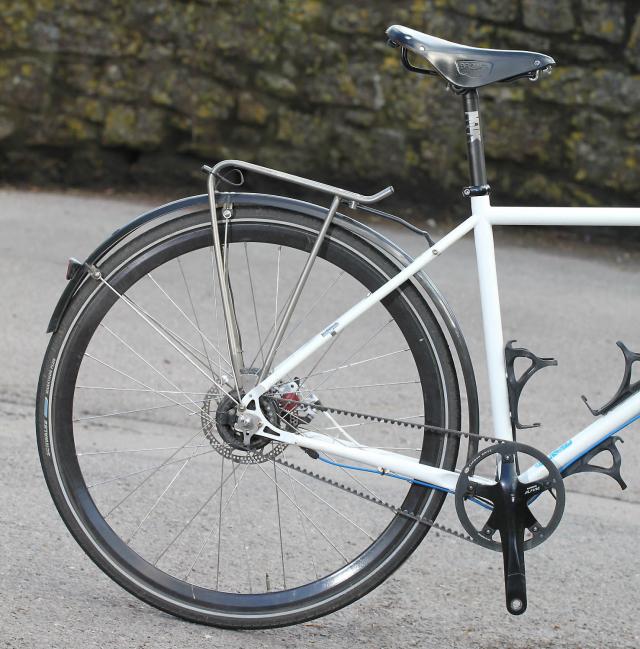
The wheels were built on 30mm deep section rims – reflective for better side visibility – sporting Schwalbe Marathon Plus tyres. Brakes were Avid's BB7 mechanical units and a Milk-branded stem, bars and seatpost, together with cork grips completed our bike.
That spec would set you back £2,135 although it's possible to have an 8-speed Alfine bike for £1,450 or an 11-speed for £1,650 with less spendy kit options. There's also a version available using Nuvinci's N360 variable transmission hub.

The ride
First impressions are of a bike that's solid and comfortable, which are good traits for a commuter. With an overall weight of 14.5kg for this build it's certainly not the quickest to spin up to speed, but the RDA is happy to roll along at a leisurely pace and the handling is neutral, making it a very easy bike to pilot.
Going downhill the bike is stable and stiff enough to handle the braking forces of the BB7 brakes without bucking or twisting, and through traffic the slightly higher position of the bike makes you feel a bit more visible than you would hunkered down over your road bike.

The always-on Supernova lighting is a real benefit in traffic too, especially when you're filtering through slow-moving cars. Plus it's plenty bright enough to keep you on the straight and narrow through the depths of winter.
Point the bike up any hill and it's immediately apparent that it's over-geared. Tapping a few numbers into the gear inch calculator reveals that the top ratio on this bike is over 120in. To put it into context, that's higher than top gear on a road bike with a 12-25 cassette and a standard 53/39 chainset. There's no earthly way that a bike like this will ever need a gear that big. Of the 11 speeds on the Alfine hub I only ever used 8, even going downhill.
I wouldn't normally make much of this, because normally you'd just bung a bigger sprocket on and take a link out of the chain. But that's not an option here; you either need to replace both chainring and sprocket, or one of the two and the belt itself. That's expensive, and the limited ability to adapt the drivetrain is an issue. It should, in any case, be right when you buy it; that really needs to be addressed.

The other thing that's apparent when going uphill is that the Alfine hub feels like it's dragging a bit due to the extra tension in the system. Belts only work well if they're under significant tension, hence the (very usable) cams on the dropouts to tighten things up. But that means more resistance to pedalling than with a chain. It's probably not a lot, but it is noticeable.
There are two main claimed benefits of the Gates belt drive: You don't need to clean or oil it; and it's wonderfully silent. That's true until you get it mucky, for instance by riding along a puddle-ridden towpath on the way to work.
Get it muddy and it starts creaking and groaning and generally being vocal and a bit annoying. The performance isn't affected, and it cleans itself in the end by pushing all the gack through the open-backed sprocket and chainring, but silent it ain't.
You can either wait for the dirt to get displaced by riding, or, well, clean it. Like you would a chain. Ironically I found that a light coating of GT85 made it much less prone to picking up dirt. Wiping off the belt and giving it a bit of a spray isn't an onerous job, but it's worth bearing in mind that the transmission is not entirely maintenance-free.

Most of my quibbles with this bike are about the belt, really. As a package it's a very likeable bike to ride: not quick, but sturdy and comfortable, ideal for day-in, day-out use.
If you're the kind of person that wants absolutely the least amount of maintenance possible, and you're going to be riding exclusively on tarmac, then the belt might well appeal to you, assuming Milk made the gearing a bit more sensible.
As specced it's clearly a pricey thing indeed, the standard builds are a lot more affordable although there's much to like about the top-end kit on this bike, especially the Schmidt/Supernova lighting.
Verdict
Very solid and likeable commuter that's built to last; the belt adds to the cost but I'm not sure it really pays its way.
road.cc test report
Make and model: Milk Bikes RDA
Size tested: L
About the bike
State the frame and fork material and method of construction. List the components used to build up the bike.
4130 Chromoly steel frame and fork
Gates Carbon belt drive
Shimano Alfine 11 hub and Shimdt Dynohub, 30mm reflective alloy rims.
Supernova E3 Pro and E3 tail lights.
Avid BB7 Road mechanical disc brakes
Schwalbe Marathon Tour tyres
Tubus Airy rear rack
Brooks B17 saddle
Milk Bikes alloy stem/flat bar/seatpost
Tell us what the bike is for, and who it's aimed at. What do the manufacturers say about it? How does that compare to your own feelings about the bike?
Milk's first production bike; a commuter dubbed RDA*.
... in fact, hang on; scrap that... 'a commuter' doesn't quite do it justice. Something like 'the ultimate commuter' is probably more appropriate. A pretty bold statement, but here's why we think we're not jumping to conclusions:
The frame and forks have been designed from the ground up, with one goal in mind – being a super-commuter. It's built with aircraft-grade 4130 chromoly steel and you can find out more about what makes the frame special here.
Milk's minimal-maintenance philosophy means belt-drive is key. Chains are simply too dirty, too noisy and a pain to clean. Check out more about how the bike gets moving here.
A bike is not complete with frames and gears alone – check out what other components we've used and those which we recommend here.
* RDA?! It stands for 'Recommended Daily Allowance'
Frame and fork
Overall rating for frame and fork
8/10
Tell us about the build quality and finish of the frame and fork?
Nicey built with tidy welds, well finished
Tell us about the materials used in the frame and fork?
4130 chromoly steel
Tell us about the geometry of the frame and fork?
73 headtube angle
73.5 seat tube angle
595mm effective top tube
150mm head tube
How was the bike in terms of height and reach? How did it compare to other bikes of the same stated size?
The L was a good fit for me (1.90m)
Riding the bike
Was the bike comfortable to ride? Tell us how you felt about the ride quality.
Comfortable and stable, but a bit sluggish
Did the bike feel stiff in the right places? Did any part of the bike feel too stiff or too flexible?
It's not the stiffest frame ever but that's not really a problem with a bike like this
How did the bike transfer power? Did it feel efficient?
The belt drive tension tends to make the Alfine hub gear feel a bit draggy
Was there any toe-clip overlap with the front wheel? If so, was it a problem?
No issues
How would you describe the steering? Was it lively, neutral or unresponsive? Neutral
Tell us some more about the handling. How did the bike feel overall? Did it do particular things well or badly?
The handling is neutral throughout
Rate the bike for efficiency of power transfer:
6/10
Rate the bike for acceleration:
4/10
Rate the bike for sprinting:
2/10
Rate the bike for high speed stability:
7/10
Rate the bike for cruising speed stability:
8/10
Rate the bike for low speed stability:
8/10
Rate the bike for flat cornering:
7/10
Rate the bike for cornering on descents:
6/10
Rate the bike for climbing:
4/10
The drivetrain
Rate the drivetrain for performance:
6/10
Rate the drivetrain for durability:
9/10
Rate the drivetrain for weight:
7/10
Rate the drivetrain for value:
7/10
Wheels and tyres
Rate the wheels and tyres for performance:
7/10
Rate the wheels and tyres for durability:
9/10
Rate the wheels and tyres for weight:
5/10
Rate the wheels and tyres for comfort:
8/10
Rate the wheels and tyres for value:
7/10
Controls
Rate the controls for performance:
7/10
Rate the controls for durability:
8/10
Rate the controls for weight:
6/10
Rate the controls for comfort:
7/10
Rate the controls for value:
7/10
Your summary
Did you enjoy riding the bike? Yes and no. It's comfortable and sturdy, but too leisurely for my style of commuting and overgeared
Would you consider buying the bike? No
Would you recommend the bike to a friend? Maybe
Rate the bike overall for performance:
6/10
Rate the bike overall for value:
6/10
About the tester
Age: 38 Height: 190cm Weight: 98kg
I usually ride: whatever I'm testing... My best bike is: Genesis Equilibrium with SRAM Apex
I've been riding for: 10-20 years I ride: Every day I would class myself as: Experienced
I regularly do the following types of riding: time trialling, cyclo cross, commuting, sportives, general fitness riding, fixed/singlespeed, mtb, Mountain Bike Bog Snorkelling, track
Dave is a founding father of road.cc, having previously worked on Cycling Plus and What Mountain Bike magazines back in the day. He also writes about e-bikes for our sister publication ebiketips. He's won three mountain bike bog snorkelling World Championships, and races at the back of the third cats.
Latest Comments
- chrisonabike 3 sec ago
Expect much more of this - at least for a while! (At least the last government didn't get the "plan for drivers" entirely through - although I'm...
- andystow 10 min 54 sec ago
Try that one punching three inches from a policeman's ear.
- Surreyrider 42 min 17 sec ago
Parcours Chrono - so good you included them twice?...
- wtjs 1 hour 5 min ago
Gloucestershire Police said: "Officers are appealing for witnesses after a child cyclist was injured in a collision in Cheltenham last week...
- hawkinspeter 1 hour 13 min ago
I often come into Bristol along the dual carriageway there as it's quicker than trying to find my way on the bike paths, but then I'm used to...
- SecretSam 1 hour 16 min ago
Mini driver. Figures.
- hawkinspeter 3 hours 24 min ago
I re-fuse to believe that not charging drivers is the current attitude
- Matthew Acton-Varian 4 hours 20 min ago
Most modern cars, especially SUV's perform very badly on the Moose test. Essentially a stunt driver has to weave through tightly spaced cones at...
- Mr Blackbird 6 hours 37 min ago
His hands are too small to reach the brake levers and his tie gets caught in the chain.




























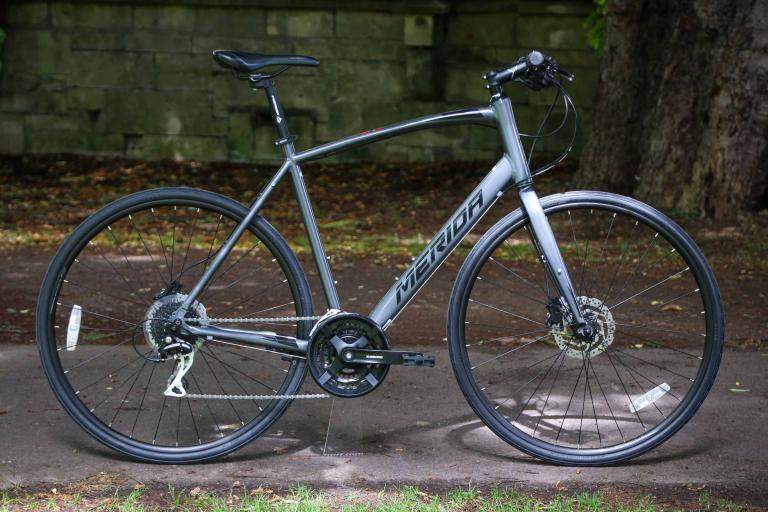
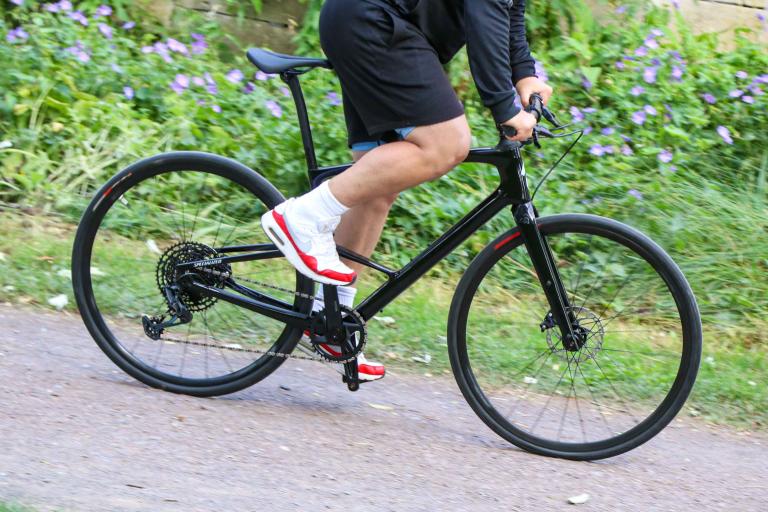
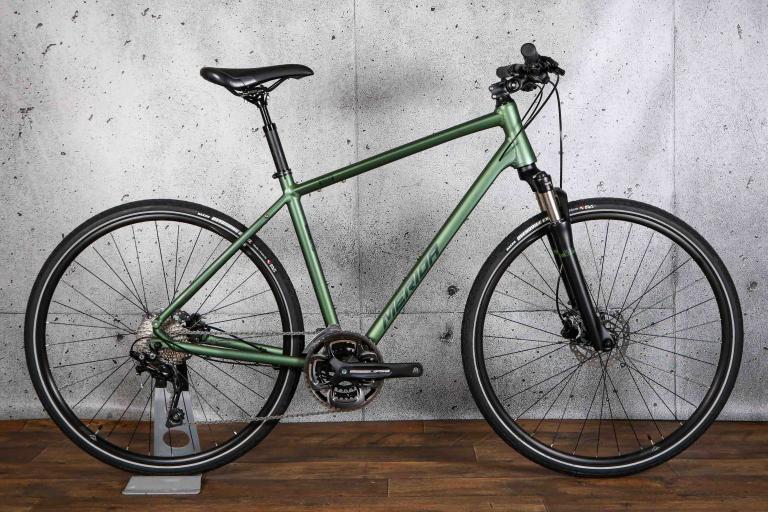
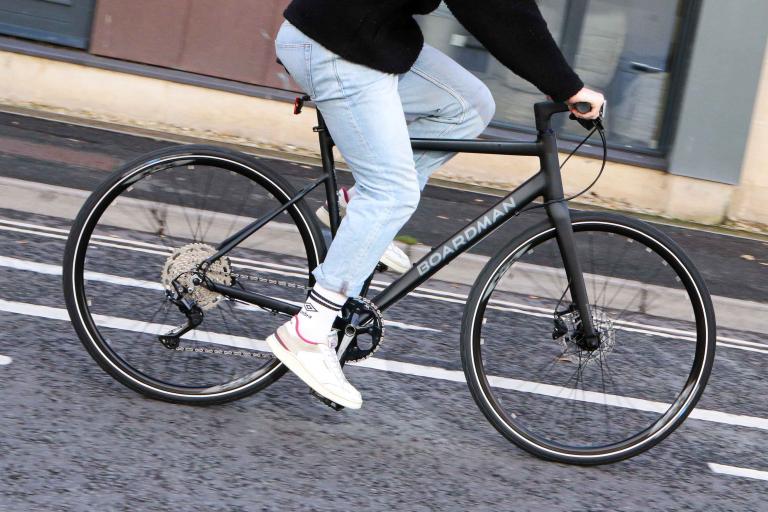
Add new comment
6 comments
Ok...
Tubus sell adaptors so you can fit a Fly to the seat stay neatly people.
They've gone for a rolls-royce finish in a flat barred bike but have specc'd BB7's instead of hydraulic brakes (and road BB7's at that.... but no drop bar levers)
There is no need for a Gates drive bike fitted with a snubber bearing to have an overly tight belt, but I can't see a snubber bearing in the pictures. And I'm sure Gates insist one is fitted....
I believe Gates sell other "chainwheel" sizes to sort the gearing but you may need another belt of a shorter length to use them.
three cages on a commuter???
Duplicate post
If were going to be picky, and why not, the rear wheel valve doesn't line up with the tire logos, the rear mudguard is badly installed, also the cable lengths are a bit suspect, wouldn't want one running infront of the light. Take it the bike has been to a lot of testers, as it looks wrecked.
Bit of a funny spec in area, heavy bike with ultra light weight rack, as its already a heavy weight, may as well have an appropriate rack like a Logo
Yeah, the bike seems really badly thrown together - the Tubus Fly rack is meant to be installed onto the seatstay bridge, not rack mounts; the high-profile rims adds unnecessary weight to a bike that isn't going to benefit from any aero advantage; the three bottle cages is unnecessary; the really, really high gearing. It's like they can't really decide what they want the bike to be.
Oof! That rack's not flat.